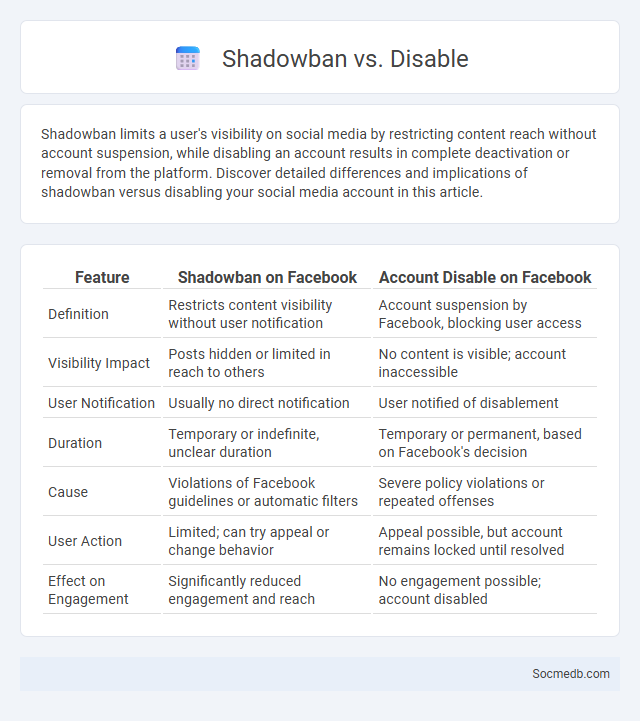
Photo illustration: Shadowban vs Disable
Shadowban limits a user's visibility on social media by restricting content reach without account suspension, while disabling an account results in complete deactivation or removal from the platform. Discover detailed differences and implications of shadowban versus disabling your social media account in this article.
Table of Comparison
| Feature | Shadowban on Facebook | Account Disable on Facebook |
|---|---|---|
| Definition | Restricts content visibility without user notification | Account suspension by Facebook, blocking user access |
| Visibility Impact | Posts hidden or limited in reach to others | No content is visible; account inaccessible |
| User Notification | Usually no direct notification | User notified of disablement |
| Duration | Temporary or indefinite, unclear duration | Temporary or permanent, based on Facebook's decision |
| Cause | Violations of Facebook guidelines or automatic filters | Severe policy violations or repeated offenses |
| User Action | Limited; can try appeal or change behavior | Appeal possible, but account remains locked until resolved |
| Effect on Engagement | Significantly reduced engagement and reach | No engagement possible; account disabled |
Introduction to Platform Restrictions: Shadowban vs Disable
Shadowban and disable are two distinct platform restrictions used by social media networks to control user activity and content visibility. Shadowban limits a user's reach by making their posts and comments invisible or less visible to others without notifying the user, effectively reducing engagement and interaction. Disable typically refers to temporarily or permanently suspending an account for violating platform policies, which prevents all user access and content sharing until the restriction is lifted or the account is reinstated.
Defining Shadowban: What It Means
A shadowban occurs when social media platforms covertly restrict your content's visibility without notifying you, limiting its reach to your followers or completely hiding it from public searches. This action is often triggered by violating community guidelines or using spam-like behavior, causing your posts to lose engagement and exposure. Understanding shadowban mechanisms helps you adjust your online activity to maintain authentic interaction and preserve your account's influence.
Understanding Account Disablement
Social media account disablement occurs when platforms restrict or suspend user access due to violations of community guidelines or suspicious activities. Common reasons include posting prohibited content, engaging in harassment, or triggering automated security filters. Understanding these policies helps users prevent disablement and facilitates timely appeals to restore accounts.
How Shadowbanning Differs from Disabling
Shadowbanning subtly restricts Your visibility on social media platforms without alerting You, causing decreased reach and engagement without notification. Disabling, on the other hand, completely blocks account access or content publication, making the restriction explicit and preventing any interaction. Understanding these differences helps You manage Your social media presence more effectively and respond to platform enforcement actions.
Common Reasons for Shadowbanning
Shadowbanning on social media often occurs due to violations of platform guidelines, such as posting spammy content, using banned hashtags, or engaging in aggressive follow/unfollow tactics. Algorithms may also flag accounts for suspected bot-like behavior or inappropriate interactions, leading to reduced visibility without user notification. Content that triggers mass user reports or automated filters can further increase the likelihood of shadowbanning across platforms like Instagram, Twitter, and TikTok.
Causes of Account Disabling
Social media account disabling often results from violations of platform policies, including inappropriate content, spam behavior, or security breaches. You may lose access due to repeated infringements of community guidelines or suspicious activity detected by automated systems. Protecting your account requires adherence to terms of service and avoiding behaviors flagged for abuse or harmful interactions.
Warning Signs: Are You Shadowbanned or Disabled?
Shadowbanning on social media occurs when a user's content is hidden or less visible without their knowledge, often due to guideline violations. Warning signs include sudden drops in engagement, followers not seeing posts, or searches excluding the user's profile. Platforms may disable accounts or limit features after repeated infractions, signaling a need to review content for compliance with community standards.
Detection Methods for Shadowban and Disable
Shadowban detection often relies on analyzing sudden drops in engagement metrics like likes, comments, or follower growth, signaling restricted content visibility on platforms such as Instagram or Twitter. Automated tools scan account performance and search rankings to identify potential shadowbans by comparing reach and impressions against baseline averages. Disabling shadowban effects involves content audits for policy violations, adjusting posting frequency, and engaging in platform-specific appeals processes to restore organic reach and visibility.
Recovery Strategies: Overcoming Shadowban and Disable
Recovery strategies for overcoming social media shadowban and account disablement include identifying shadowban symptoms through engagement drops and hashtag visibility checks. Users should appeal to platform support, review community guidelines compliance, and adjust content to avoid spam-like behavior or algorithm triggers. Consistent, authentic interaction with followers and gradual posting restores account credibility and visibility.
Preventive Measures to Avoid Both Issues
Taking preventive measures on social media involves setting strong privacy settings, avoiding sharing sensitive personal information, and using two-factor authentication to protect your accounts from unauthorized access. You should regularly update passwords and be cautious of suspicious links or friend requests to prevent phishing and hacking attempts. Implementing these strategies reduces the risk of privacy breaches and cyberbullying, ensuring a safer online experience.
 socmedb.com
socmedb.com